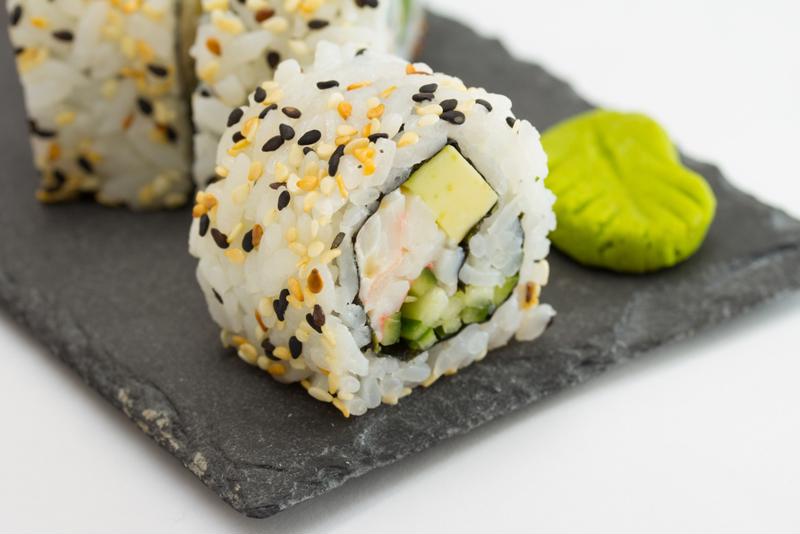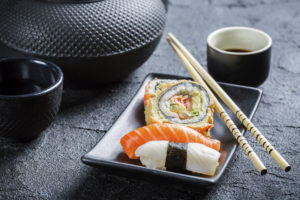If you enroll in online cooking courses, you will learn about a great variety of cuisines, including many new culinary techniques. Sometimes, though, it’s just as important to understand how social expectations and cultural traditions can affect the dining experience. Sushi is one type of food that is tied to a long history and great importance in Japanese culture. Here are some tips to keep in mind when you are visiting a sushi bar.
Know your sushi basics
If you have little experience with sushi, some introductory vocabulary will be helpful. The most common dishes available at American sushi restaurants are sashimi, nigiri and maki. As Serious Eats explained, “sushi” is technically not the name of any kind of fish. Rather, the terms refers to the sticky rice made with vinegar that is commonly used in these dishes.
“‘Sushi’ is not the name of any kind of fish.”
According to Spoon University, nigiri, which takes its name from the Japanese word for “grip,” is made by rolling up rice with fish and vegetables inside, usually with an exterior covering of seaweed. Sashimi is just the raw fish, without any rice. Maki, which is available in far more varieties in the U.S. than traditional Japanese sushi bars, are rolls of fish and rice that are generally wrapped in seaweed and cut into several pieces.
Talk to the chef
Cookbook author Hiroko Shimbo offered Bon Appetit advice on how to obtain the freshest, tastiest fish. She said that customers demonstrate a serious interest in the food by sitting at the sushi bar and politely getting the chef’s attention. Ask his or her recommendation for what is freshest that day, and you will likely be treated well. Of course, you should be respectful of the chef’s time, and, especially if the restaurant is busy, make any exchanges brief and direct.
Eat with your hands
Those who are new to eating sushi are often uncertain when it is acceptable to eat with their hands as opposed to using chopsticks. According to Los Angeles Magazine, since sushi has its origins as a finger food, eating with your fingers is never impolite. Use whichever method makes you more comfortable.
That said, some guidelines may help you to avoid practical difficulties as you dig into your meal. It is generally best to eat nigiri with your fingers, since it is otherwise likely to crumble apart when pinched with chopsticks. Sashimi, on the other hand, may call for chopsticks as you dip it in a mixture of wasabi and soy sauce.
If possible, eat each piece in one bite. Pieces of sushi tend to be larger in the U.S. than in Japan, so this can become difficult. Nonetheless, sticking to items that you can easily fit in your mouth will result in a more flavorful and less messy experience.
Dip in moderation
Avoid drowning your sushi’s flavor in too much soy sauce. The fish will usually have plenty of seasoning without any additional condiment. Keep the amount of sauce in your dish limited to prevent mishaps, and give each piece just a light smattering. Note also that, unlike sashimi, nigiri comes with some wasabi in between the rice and fish. Adding more wasabi to your sauce is unnecessary.
As CNN pointed out, sushi experts recommend flipping each piece over before dipping it in soy sauce. Otherwise, you risk the rice base falling apart and the flavor of the fish being overwhelmed by saltiness. Be aware that the flipping maneuver may require some practice before you can perform it fluidly, holding all components in place.
 Avoid overwhelming your food’s flavor with too much soy sauce.
Avoid overwhelming your food’s flavor with too much soy sauce.Don’t take too long
When eating sushi, it is considered detrimental to your own dining experience and impolite to the chef if you linger too long with food in front of you. Your freshly prepared fish loses some of its ideal flavor over time. Moreover, while sushi bar proprietors generally have no objection to you ordering and reordering food until you are fully satisfied, leaving an piece of sushi you were served uneaten is considered a serious faux pas, unless there is something wrong with it.
Follow these tips to get the most out of your experience at a sushi bar. Remember, when you are in culinary academy, every trip out to dinner is an opportunity for a learning experience that can make you a better chef.





